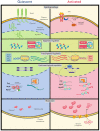A Long Journey before Cycling: Regulation of Quiescence Exit in Adult Muscle Satellite Cells
- PMID: 35163665
- PMCID: PMC8836154
- DOI: 10.3390/ijms23031748
A Long Journey before Cycling: Regulation of Quiescence Exit in Adult Muscle Satellite Cells
Abstract
Skeletal muscle harbors a pool of stem cells called muscle satellite cells (MuSCs) that are mainly responsible for its robust regenerative capacities. Adult satellite cells are mitotically quiescent in uninjured muscles under homeostasis, but they exit quiescence upon injury to re-enter the cell cycle to proliferate. While most of the expanded satellites cells differentiate and fuse to form new myofibers, some undergo self-renewal to replenish the stem cell pool. Specifically, quiescence exit describes the initial transition of MuSCs from quiescence to the first cell cycle, which takes much longer than the time required for subsequent cell cycles and involves drastic changes in cell size, epigenetic and transcriptomic profiles, and metabolic status. It is, therefore, an essential period indispensable for the success of muscle regeneration. Diverse mechanisms exist in MuSCs to regulate quiescence exit. In this review, we summarize key events that occur during quiescence exit in MuSCs and discuss the molecular regulation of this process with an emphasis on multiple levels of intrinsic regulatory mechanisms. A comprehensive understanding of how quiescence exit is regulated will facilitate satellite cell-based muscle regenerative therapies and advance their applications in various disease and aging conditions.
Keywords: cell cycle re-entry; cell growth; checkpoints; mTORC1; quiescence exit; satellite cells.
Conflict of interest statement
The authors declare no conflict of interest.
Figures


Similar articles
-
p110α of PI3K is necessary and sufficient for quiescence exit in adult muscle satellite cells.EMBO J. 2018 Apr 13;37(8):e98239. doi: 10.15252/embj.201798239. Epub 2018 Mar 26. EMBO J. 2018. PMID: 29581096 Free PMC article.
-
Paxbp1 controls a key checkpoint for cell growth and survival during early activation of quiescent muscle satellite cells.Proc Natl Acad Sci U S A. 2021 Mar 30;118(13):e2021093118. doi: 10.1073/pnas.2021093118. Proc Natl Acad Sci U S A. 2021. PMID: 33753492 Free PMC article.
-
Dormancy and quiescence of skeletal muscle stem cells.Results Probl Cell Differ. 2015;56:215-35. doi: 10.1007/978-3-662-44608-9_10. Results Probl Cell Differ. 2015. PMID: 25344673 Review.
-
Intrinsic and extrinsic mechanisms regulating satellite cell function.Development. 2015 May 1;142(9):1572-81. doi: 10.1242/dev.114223. Development. 2015. PMID: 25922523 Free PMC article. Review.
-
Tubastatin A maintains adult skeletal muscle stem cells in a quiescent state ex vivo and improves their engraftment ability in vivo.Stem Cell Reports. 2022 Jan 11;17(1):82-95. doi: 10.1016/j.stemcr.2021.11.012. Stem Cell Reports. 2022. PMID: 35021050 Free PMC article.
Cited by
-
Characteristics of bovine muscle satellite cell from different breeds for efficient production of cultured meat.J Anim Sci Technol. 2024 Nov;66(6):1257-1272. doi: 10.5187/jast.2023.e115. Epub 2024 Nov 30. J Anim Sci Technol. 2024. PMID: 39691610 Free PMC article.
-
Pvr regulates cyst stem cell division in the Drosophila testis niche, and has functions distinct from Egfr.Cells Dev. 2023 Mar;173:203822. doi: 10.1016/j.cdev.2022.203822. Epub 2022 Nov 16. Cells Dev. 2023. PMID: 36400422 Free PMC article.
-
Intravital microscopy of satellite cell dynamics and their interaction with myeloid cells during skeletal muscle regeneration.Sci Adv. 2023 Oct 20;9(42):eadi1891. doi: 10.1126/sciadv.adi1891. Epub 2023 Oct 18. Sci Adv. 2023. PMID: 37851799 Free PMC article.
-
Sugt1 loss in skeletal muscle stem cells impairs muscle regeneration and causes premature muscle aging.Life Med. 2023 Nov 2;2(4):lnad039. doi: 10.1093/lifemedi/lnad039. eCollection 2023 Aug. Life Med. 2023. PMID: 39872547 Free PMC article.
-
ATF3 induction prevents precocious activation of skeletal muscle stem cell by regulating H2B expression.Nat Commun. 2023 Aug 17;14(1):4978. doi: 10.1038/s41467-023-40465-w. Nat Commun. 2023. PMID: 37591871 Free PMC article.
References
Publication types
MeSH terms
Substances
Grants and funding
LinkOut - more resources
Full Text Sources

